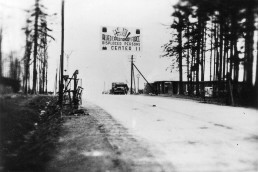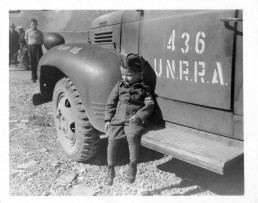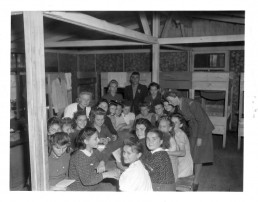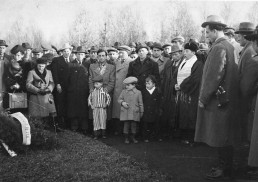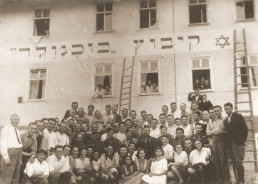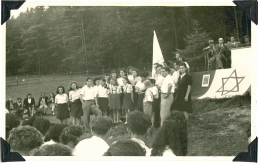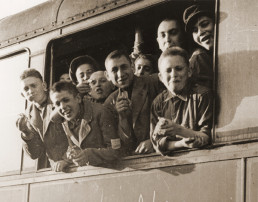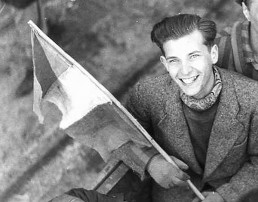Buchenwald DP camp and Kibbutz
In the course of World War II, the Germans deported several million people to the German Reich. After liberation, the Allies registered them as Displaced Persons (DP) and organized their return to their countries of origin. DPs were not only concentration camp survivors, but also liberated civilian forced laborers, especially from Eastern Europe.
After the war, DP camps were set up in all German occupation zones, including at the liberated Buchenwald and Mittelbau-Dora camps. For many survivors, however, repatriation was not possible, especially for the Jewish orphans. Some of them founded the Kibbutz Buchenwald in order to prepare for their joint departure to Palestine and their future life in a Jewish community.
In early July 1945, Thuringia became part of the Soviet occupation zone. The Buchenwald DP camp was transformed into a “repatriation camp” under Soviet management and was disbanded in October 1945.
Allied banner at the main entrance of the Displaced Persons Center II in Buchenwald, April/May 1945.
After the liberation of the concentration camps, about 2,000 DP camps were established in Germany, Austria and Italy. The former Buchenwald Concentration Camp served as a reception and transit camp for former prisoners and forced laborers.
(Photo: Alfred Stüber, Buchenwald Memorial)
Joseph Schleifstein on a UNRRA truck at the Buchenwald DP camp, after 11 April 1945.
The United Nations Relief and Rehabilitation Administration (UNRRA) was responsible for the DP camps and organized the repatriation of the survivors to their countries of origin. The photo of the 4-year-old concentration camp survivor Joseph Schleifstein was taken at the liberated Buchenwald camp.
(United States Holocaust Memorial Museum)
A UNRRA staff member with orphans in the Dora DP camp, 29 June 29 1945.
A DP camp was also established in the liberated Mittelbau-Dora Concentration Camp. In May 1945, more than 20,000 liberated forced laborers and several hundred concentration camp survivors were housed here. UNRRA staff took care of orphans whose parents had died as forced laborers or concentration camp prisoners.
(Photo: Edward Vetrone, Mittelbau-Dora Concentration Camp Memorial)
Commemoration ceremony organized by Jewish DPs in the liberated Buchenwald camp, June 1945.
In the Buchenwald DP camp, survivors organized many cultural events shortly after liberation. These included religious festivals and services as well as commemoration of the dead. At the center is Joseph Schleifstein wearing his striped prisoner suit.
(United States Holocaust Memorial Museum)
"Of the survivors, a considerable number will endeavor to find a new home in Palestine. After the unspeakable suffering that these people have endured, it is the duty of the Zionist public to fight to ensure that these Zionists are offered the opportunity to immigrate to Eretz Israel as soon as possible. [...] Obtain special certificates for children and young people who are still [...] in the camps and most of whom are orphans. Create for these children the possibility of a hakhshara in Western Europe, otherwise they will become dependent on public welfare when they return to their former homeland. Save the rest of the Jewish youth in Central Europe!"
"Obtain special certificates for children and youth". Appeal of the Jewish Relief Committee, 22 April 1945.
Palestine was one of the main destinations for emigration of Jewish survivors. Until the establishment of the State of Israel in May 1948, the country was still under British Mandate, and entry was strictly regulated. The Zionist movement had established so called hachsharas as early as the 1920s to offer agricultural training in preparation for emigration.
(Ghetto Fighters’ House – Beit Lochamei HaGeta’ot )
Young members of Kibbutz Buchenwald sing partisan songs outdoors at Gehringshof, summer 1946.
The Kibbutz Buchenwald at Gehringshof existed from June 1945 to October 1948. During the preparations for departure to Palestine, a variety of cultural events took place there. In 1948, the Kibbutz moved to Israel and in 1950 it changed its name to Netzer Sereni.
(Photo: David Marcus, United States Holocaust Memorial Museum)
Kibbutz Buchenwald. Group photo in front of the agricultural training center in Gehringshof, 1945.
On 3 June 1945, Jewish survivors founded the Kibbutz Buchenwald in Eggendorf near Weimar. Before Thuringia became part of the Soviet occupation zone in July 1945, the approximately 50 members, most of them adolescents, moved to Gehringshof near Fulda. Kibbutz Buchenwald (written in Hebrew letters on the wall of the house) served as preparation for emigration to Palestine.
(United States Holocaust Memorial Museum)
FURTHER INFORMATION:
Juliane Wetzel: Displaced Persons (DPs), in: Historisches Lexikon Bayerns,
historisches-lexikon-bayerns.de.
After liberation
Children’s transports after the liberation
The parents and other relatives of the approximately 900 underage survivors of the Buchenwald Concentration Camp had almost all been murdered. Other orphans were brought to Buchenwald from…
Return home
The liberated children and adolescents wanted nothing more than to return home to their families.
